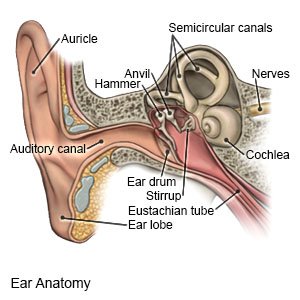Myringoplasty and Tympanoplasty
Medically reviewed by Drugs.com. Last updated on Apr 6, 2025.
Myringoplasty and tympanoplasty are surgeries used to close a hole in your eardrum. This helps prevent middle ear infections and may improve your hearing. A graft is placed over the hole. Grafts are commonly made from a piece of fascia (hard tissue that covers muscles), bone, vein, or cartilage. A paper or gel graft is sometimes used for small holes.
 |
DISCHARGE INSTRUCTIONS:
Call your local emergency number (911 in the US) if:
- You have sudden chest pain that is worse when you take a deep breath.
- You feel lightheaded, short of breath, or have chest pain.
- You cough up blood.
Seek care immediately if:
- Your stitches come apart.
- Blood or drainage soaks through your bandage.
- You have worsening pain, swelling, or drainage in or behind your ear.
- You have trouble making the muscles in your face move.
- You have hearing loss that is worse than before your surgery, or you cannot hear anything.
- Your leg feels warm, tender, and painful. It may look swollen and red.
Call your surgeon or otolaryngologist if:
- You have a headache that does not go away even after you take pain medicine.
- You have a fever.
- You have nausea or are vomiting.
- Your surgery site is swollen, red, or has pus coming from it.
- You have questions or concerns about your condition or care.
Medicines:
You may need any of the following:
- Antibiotics fight or prevent an ear infection caused by bacteria. They may be given as pills or eardrops.
- Antihistamines help prevent symptoms of respiratory allergies, such as sneezing or itching.
- Steroids decrease pain and swelling.
- Prescription pain medicine may be given. Ask your healthcare provider how to take this medicine safely. Some prescription pain medicines contain acetaminophen. Do not take other medicines that contain acetaminophen without talking to your healthcare provider. Too much acetaminophen may cause liver damage. Prescription pain medicine may cause constipation. Ask your healthcare provider how to prevent or treat constipation.
- Take your medicine as directed. Contact your healthcare provider if you think your medicine is not helping or if you have side effects. Tell your provider if you are allergic to any medicine. Keep a list of the medicines, vitamins, and herbs you take. Include the amounts, and when and why you take them. Bring the list or the pill bottles to follow-up visits. Carry your medicine list with you in case of an emergency.
Self-care:
- Move slowly and carefully. You may become dizzy if you move too quickly.
- Protect your eardrum until it is healed. Avoid actions that can put pressure on your inner ear, harm the graft, or let bacteria into your inner ear. Do not lean forward, lift heavy objects, get water in your ear, or cough or sneeze. If it is necessary to cough or sneeze, keep your mouth open. Your healthcare provider may give you more directions on protecting the surgery area.
- Care for the surgery area, if needed. This is needed if the incision was made behind your ear. Clean the area as often as directed. Your healthcare provider will tell you what to use to clean the area. Change the bandage each day, and if it gets dirty, wet, or full of drainage. Check the area each day for signs of infection, such as swelling, redness, or pus.
- Prevent an infection. You may be told to put a cotton ball in your outer ear when you go outside for a week after surgery. Avoid crowds and be careful around anyone who has a cold. It is important to do this to prevent an upper respiratory infection. Wash your hands often with soap and water. Use a gel-based hand sanitizer if soap and water are not available. Always wash before you care for your surgery area.

- Do not smoke. Nicotine and other chemicals in cigarettes and cigars can delay healing or lead to an infection. Ask your healthcare provider for information if you currently smoke and need help to quit. E-cigarettes or smokeless tobacco still contain nicotine. Talk to your healthcare provider before you use these products.
Follow up with your surgeon or otolaryngologist as directed:
You will need to return to have your ears checked. You may need to have your stitches removed. The bandage inside your ear will be removed 3 to 4 weeks after your surgery. You may also need to have regular visits to check your hearing. Write down your questions so you remember to ask them during your visits.
© Copyright Merative 2025 Information is for End User's use only and may not be sold, redistributed or otherwise used for commercial purposes.
The above information is an educational aid only. It is not intended as medical advice for individual conditions or treatments. Talk to your doctor, nurse or pharmacist before following any medical regimen to see if it is safe and effective for you.
Further information
Always consult your healthcare provider to ensure the information displayed on this page applies to your personal circumstances.
